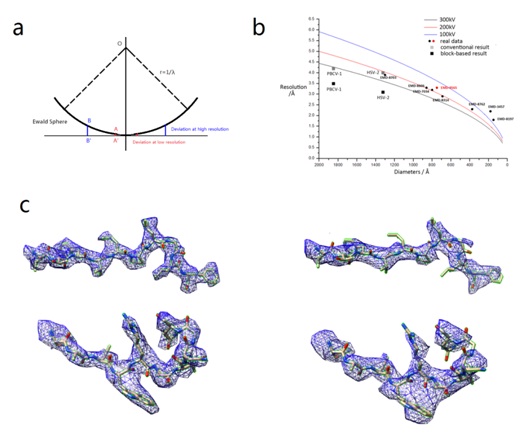Block-based Reconstruction method breaks the Ewald sphere limitation in cryo-EM
On April 19th, 2018, the research article “Pushing the resolution limit by correcting the Ewald sphere effect in single-particle Cryo-EM reconstructions” was open accessed in Nature Communications, which is a work from ZHANG Xinzheng’s Lab. In this work, the resolution limit of the cryo-EM single particle analysis (SPA) method by Ewald sphere effect was studied and a method called “Block-based Reconstruction” was developed to overcome the Ewald sphere effect and extend the resolution. With the association of per particle defocus measurement and refinement, for the first time, the researchers corrected the Ewald sphere effect and push the resolution over the limit by Ewald sphere effect on the real cryo-EM single particle data. This method helps the study on large viruses such as herpesvirus and Nucleocytoplasmic large DNA viruses, and it will contribute cryo-EM SPA to achieve atomic resolution in the future. The cryo-EM images reflect the information of the sample along the Ewald sphere in reciprocal space. In current reconstruction theory, Ewald sphere is regarded as a plane. This approximation causes a resolution limitation known as the Ewald sphere limit. Many methods have been proposed in the past to overcome the limit, such as defocus-gradient corrected back-projection (Jensen G. J et al., 2000), Prec (Leong P.A. et al., 2010), side-band image processing (Russo C et al., 2018). All of them showed brilliant results on simulated data or inorganic high-contrast data, but none had shown works for real low SNR cryo-EM data.
To overcome the Ewald sphere limit, we propose the Block-based reconstruction method based on the fact that the Ewald sphere effect is equivalent with the depth-of-field effect in cryo-EM. This method divides the whole 3D object into smaller blocks. The local mean defoci of blocks can be calculated, and then the blocks are local refined and reconstructed using the local mean defoci. With the help of our home-made per particle defocus refinement program, we tested the method on two large virus datasets: HSV-2 virus capsid with the diameter of ~120nm and PBCV-1 virus with the diameter of ~200nm. The block-based reconstruction improved the resolutions of HSV-2 capsid and PBCV-1 virus from 4.0 ? and 4.2? (conventional SPA procedure) to 3.1 ? and 3.5 ?, respectively. Both results extended the Ewald sphere resolution limit and partially overcame the flexibility of the viruses. The result of HSV-2 capsid in 3.1 ? was published earlier (Yuan et al., Science 360, 48 (2018)).
Prof. ZHANG Xinzheng from Institute of Biophysics of Chinese academy of Science (IBP) is the corresponding author and ZHU Dongjie, a joint student from IBP and University of Science and Technology of China is the first author. Prof. RAO Zihe and Prof. WANG Xiangxi from IBP, Prof. Michael G Rossmann and Dr. FANG Qianglin from Purdue University, Prof. James L Van Etten from University of Nebraska-Lincoln also participate in this work. The project is supported by the National Key R&D Program of China, the Strategic Priority Research Program of CAS.

a. The Ewald sphere effect; b. The Ewald sphere limit and the resolution from block-based reconstruction; c. Density from the same area of the reconstruction of the block (left) and the density from the conventional SPA result (right)
Contact:ZHANG Xinzheng
Institute of Biophysics, Chinese Academy of Sciences, Beijing 100101, China
Phone: 86-10-64888490
Email: xzzhang(AT)ibp.ac.cn

